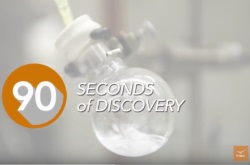
Recycling carbon dioxide
By David Heldebrant

Our power plants emit a lot of carbon dioxide when we produce electricity. An average 550 MW coal-fired power plant puts out about a million pounds of carbon dioxide per hour. These power plants emit so much carbon dioxide to the atmosphere that this heat-trapping gas is slowly warming our planet like a greenhouse.
We need strategies to reduce the amount of carbon dioxide in the atmosphere. Living plants—trees, grasses, shrubs—efficiently remove carbon dioxide from the atmosphere and sequester it into biomass using solar energy. How could we copy that ability? Read more.
Carbonates: A Promising Approach for Low-Temperature Carbon Dioxide Conversions
By Vanda Glezakou and Roger Rousseau
Almost two hundred years into the Industrial Revolution, we are faced with a mounting problem regarding fossil fuel use—too much carbon dioxide in the air. Turning carbon dioxide into fuels would address two energy issues at once: reducing the gas's accumulation in the atmosphere and recycling the finite resource that is fossil fuels. While others are exploring ways to collect carbon dioxide from power plant exhaust and use it as a raw material in industrial processes, we think it may also be possible to recycle the carbon dioxide back into fuels via a novel chemistry involving the conversion of carbonates. Read more.
90 Seconds of Discovery:
Carbonated Science Cleans Power Plants
 Similar to the properties of soda, liquid solvents can efficiently capture and convert carbon dioxide from coal power plants. Researchers at PNNL explain this process and how this method can turn captured carbon into plastic or fuel. Watch the video.
Similar to the properties of soda, liquid solvents can efficiently capture and convert carbon dioxide from coal power plants. Researchers at PNNL explain this process and how this method can turn captured carbon into plastic or fuel. Watch the video.
August 2017
Catalysis News
Zdenek Dohnalek Named AVS Fellow. The deputy director of the Institute for Integrated Catalysis Zdenek Dohnálek was recognized for his contributions toward understanding the elementary steps of catalytic reactions on oxides. Read more.
A Duet of Firsts: Imaging Chemical Building Block. Scientists break the bottleneck of imaging complex building blocks for molecular sieves and catalysts, allowing for the structure to be resolved at the near-atomic level. Read more.
Johannes Lercher Elected to Membership in the National Academy of Engineering. Lercher recognized for distinguished contributions and professional integrity. His work focuses on how catalysts work at the elementary level and uses that insight to design and build better catalysts for industrial applications. Read more.
Interdisciplinary teams at Pacific Northwest National Laboratory address many of America's most pressing issues in energy, the environment and national security through advances in basic and applied science. Founded in 1965, PNNL employs 4,400 staff and has an annual budget of nearly $1 billion. It is managed by Battelle for the U.S. Department of Energy's Office of Science. As the single largest supporter of basic research in the physical sciences in the United States, the Office of Science is working to address some of the most pressing challenges of our time. For more information on PNNL, visit the PNNL News Center, or follow PNNL on Facebook, Google+, LinkedIn and Twitter.
EMSL, the Environmental Molecular Sciences Laboratory, is a DOE Office of Science user facility. Located at Pacific Northwest National Laboratory in Richland, Wash., EMSL offers an open, collaborative environment for scientific discovery to researchers around the world. Its integrated computational and experimental resources enable researchers to realize important scientific insights and create new technologies.
If you have feedback – ideas, suggestions or questions – about IIC's Transformations, please contact Kristin Manke.